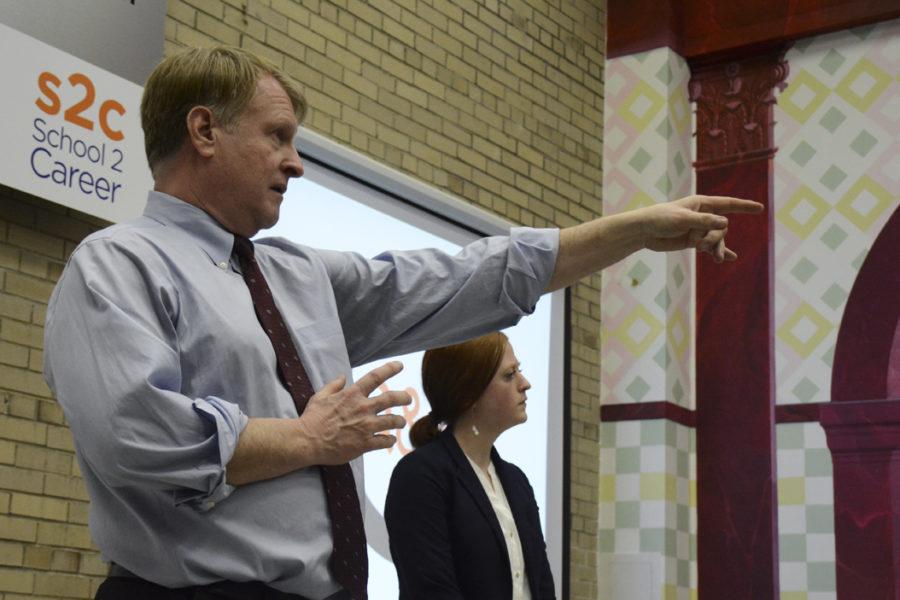After introducing new routes for the Bus Rapid Transit, the Pittsburgh Port Authority approached locals at the Oakland Planning and Development Corporation town hall meeting for their opinion.
About 30 local Pittsburgh residents attended the OPDC town hall meeting at the Oakland Career Center Wednesday night. The discussion focused on plans for a new land trust program and gathering resident feedback on the Port Authority’s BRT system — or what the Port Authority team referred to as “a light rail on wheels.” Attendees recorded their feedback in a survey and then took to the floor to talk to representatives from OPDC and the Port Authority.
The majority of the meeting focused on presenting the BRT, a new electric bus system that would travel on specially designated lanes from Oakland to Downtown. The Port Authority, which has been developing the project, released possible plans for the BRT routes March 9.
Senior Planner for the Pittsburgh Department of City Planning Justin Miller said BRT is still its early stages. He said the system would use electric-powered buses capable of traveling faster than gas-powered buses, primarily running from Oakland to Downtown, and vice versa. Beyond speed, the new transit system would also allow for better traffic flow patterns and possibly the installation of more bike lanes.
A representative from OPDC handed each attendant a packet at the beginning of the meeting to collect feedback about the current bus system in place and their preferred BRT route. They offered four route choices, all of which included a direct route from Oakland to Downtown: one extending from Downtown to Squirrel Hill, one branching to Highland Park, and two that run directly between Oakland and Downtown.
Amy Silbermann, senior analyst for the Port Authority, said she and her team will gauge public interest until the end of April so they can apply for a grant in the fall and potentially have the system in place as early as 2021.
After the presentation on BRT logistics, Port Authority representatives responded to concerns brought up by Oakland residents, including concerns about the transit system’s accessibility for elderly and people traveling to places other than Downtown.
Ethel Deiulis, 77, said the new system is geared toward young people who could make the trek to Fifth or Forbes — where the BRT system is planned to run — unlike older residents like herself.
“Older people — we have all our stuff here,” Deiulis said. “We don’t need to get Downtown, we’ve got our churches and educational centers and medical centers here in Oakland. This is a system for young people.”
Others worried the system would leave out community members outside of Downtown or Oakland, such as residential communities in Panther Hollow or Homestead. Silbermann said the new system should revolve around connecting Oakland to Downtown because these two areas are the biggest job creators.
“The universities are the heart of our economy in this region, I don’t want to hurt them,” Miller said. “The idea is to have everyone together, the biker, the rider, the vehicular rider, to make it safer for everyone.”
Overall, Port Authority representatives stressed that a major perk of the new transit system was increased safety.
In past meetings, Oakland residents have complained about students in Oakland breaking laws regarding maximum housing occupancy, reselling parking passes and generally leaving the neighborhood looking trashed.
The OPDC announced Wednesday it will be responding to complaints about housing issues with a new initiative to make Oakland more resident-friendly, referred to as the Oakland Community Land Trust.
The Oakland CLT is a program that seeks to conserve property by buying up large areas of land. According to OPDC board member Peter Bruten, the OPDC hopes to use CLT as a means to ensure Oakland is primarily being occupied by permanent homeowners. The OPDC plans to buy Oakland homes, and selectively sell them to people who plan to live in those homes long term. The OPDC thinks that establishing more long-term homeowners in Oakland will make the community more livable in general.
Attendees brought up concerns that a land trust’s authority would be disregarded, as tenants often disregard landlords’ rules now by filling homes past their capacity.
Wanda Wilson, the OPDC executive director, gave the short answer to this concern: “It’s all we can do.”



